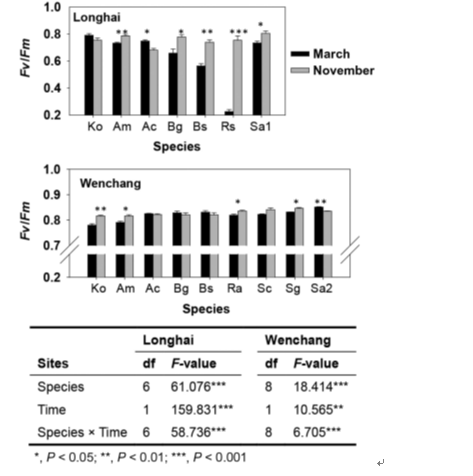作 者:Chen, LZ; Wang, WQ; Li, QSQ; Zhang, YH; Yang, SC; Osland, MJ; Huang, JL; Peng, CJ
影响因子:2.49
刊物名称:ECOSPHERE
出版年份:2017
卷:8(6) 页码: e01865
The global distribution and diversity of mangrove forests is greatly influenced by the frequency
and intensity of winter air temperature extremes. However, our understanding of how different
mangrove species respond to winter temperature extremes has been lacking because extreme freezing and
chilling events are, by definition, relatively uncommon and also difficult to replicate experimentally. In this
study, we investigated species-specific variation in mangrove responses to winter temperature extremes in
China. In 10 sites that span a latitudinal gradient, we quantified species-specific damage and recovery
following a chilling event, for mangrove species within and outside of their natural range (i.e., native and
non-native species, respectively). To characterize plant stress, we measured tree defoliation and chlorophyll
fluorescence approximately one month following the chilling event. To quantify recovery, we measured
chlorophyll fluorescence approximately nine months after the chilling event. Our results show high
variation in the geographic- and species-specific responses of mangroves to winter temperature extremes.
While many species were sensitive to the chilling temperatures (e.g., Bruguiera sexangula and species in the
Sonneratia and Rhizophora genera), the temperatures during this event were not cold enough to affect certain
species (e.g., Kandelia obovata, Aegiceras corniculatum, Avicennia marina, and Bruguiera gymnorrhiza). As
expected, non-native species were less tolerant of winter temperature extremes than native species. Interestingly,
tidal inundation modulated the effects of chilling. In comparison with other temperaturecontrolled
mangrove range limits across the world, the mangrove range limit in China is unique due to the
combination of the following three factors: (1) Mangrove species diversity is comparatively high; (2) winter
air temperature extremes, rather than means, are particularly intense and play an important ecological role;
and (3) due to afforestation and restoration efforts, several species of non-native mangroves have been
introduced beyond their natural range limits. Hence, from a global perspective, mangroves in China provide
valuable opportunities to advance understanding of the effects of freezing and chilling temperatures
on mangroves. Within the context of climate change, our findings provide a foundation for better understanding
and preparing for mangrove species-specific responses to future changes in the duration and
intensity of winter temperature extremes.

Fig.5.Maximum photochemical efficiency of PSII
(ΦPSII; mean _ SE Fv/Fm) of mangrove species at two
study sites (Longhai and Wenchang) following the
2008 chilling event. March and November measurements
were taken approximately one and nine months
after the event, respectively. Univariate ANOVA
results are also shown. Ko, Kandelia obovata; Am, Avicennia
marina; Ac, Aegiceras corniculatum; Bg, Bruguiera
gymnorrhiza; Bs, Bruguiera sexangula; Rs, Rhizophora
stylosa; Ra, Rhizophora apiculata; Sc, Sonneratia caseolaris;
Sg, Sonneratia 9 gulngai; Sa1, Sonneratia apetala; Sa2,
Sonneratia alba.

